.
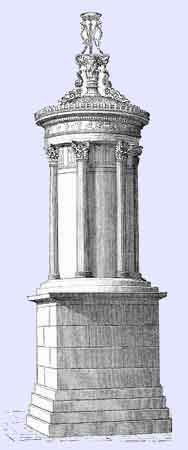
The Choragic Monument of Lysicrates near the Acropolis of Athens was erected by the choragos Lysicrates, a patron of many theatrical performances in the Theater of Dionysus, to commemorate the award of first prize in the 111th Olympiad, 335 BC or 334 BC, to one of the performances he had sponsored. The choragos was the sponsor who paid for and supervised the training of the dramatic dance-chorus (of children of the Acamantis phyle) according to an inscription found:
«Λυσικράτης Λυσιθείδου Κικυνεύς εχορήγει
Ακαμαντίς παίδων ενίκα θέων ηύλει
Λυσιάδας Αθηναίος εδίδασκε Ευαίνετος ήρχε»
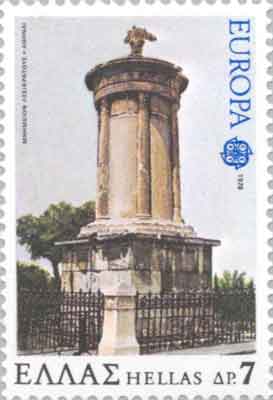
The circular structure, raised on a high squared podium, is one of the first Greek monuments built according to the Corinthian order. Its frieze sculptures depict episodes from the myth of Dionysus, (such as the pirates transformed into dolphins) the god whose rites developed into Greek theatre. It originally served as support for the bronze tripod that was given as prize. it stands now in its little garden on the Tripodon Street ("Street of the Tripods"), which follows the line of the ancient street of the name, which led to the Theater of Dionysus and was once lined with choragic monuments, of which the foundations were discovered in excavations during the 1980s.


In 1658, a French Capuchin monastery was founded by the site; the monastery succeeded in purchasing the monument (then being called the "Lantern of Diogenes") from the Ottoman resident (1669). The monument became famous in France and England through engravings of it, and "improved" versions became eye-catching features in several English landscape gardens. Lord Byron stayed at the monastery during his second visit to Greece. In 1818, friar Francis planted in its gardens the first tomato plants in Greece. In 1829, the monks offered the structure to an Englishman on tour, but it proved to be too cumbersome to disassemble and ship. Lord Elgin negotiated unsuccessfully for the monument, by then an icon in the Greek Revival.
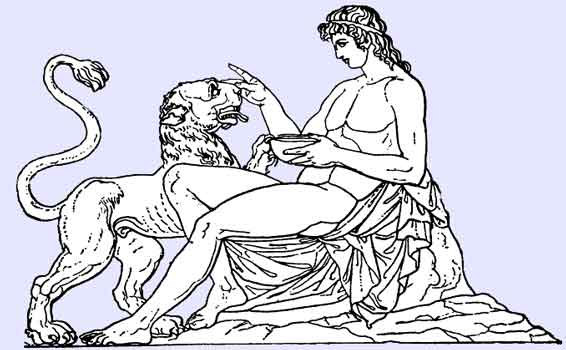
Dionysus and Panther , Relief, Lysicrates Monument, Athens
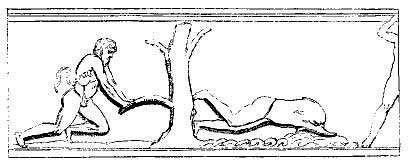
Relief, Transformation of a pirate into a dolphin

Dionysus Relief, Lysicrates Monument
The monastery was demolished during the Greek war of Independence, 1821. French archaeologists cleared the rubble from the half-buried monument and searched the area for missing architectural parts. In 1876-1887 the architects François Boulanger and E. Loviot supervised a restoration under the auspices of the French Government.
Famous English versions of the Choragic Monument appear in the gardens at Shugborough, Staffordshire and Alton Towers, among many others.
In the US, the Choragic Monument was adapted for Civil War memorials in Connecticut , and capped many Beaux-Arts towers.
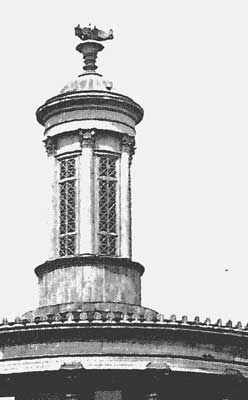
Merchants Exchange, Philadelphia USA, William Strickland, 1834
Monument of Lysicrates 1870 Image
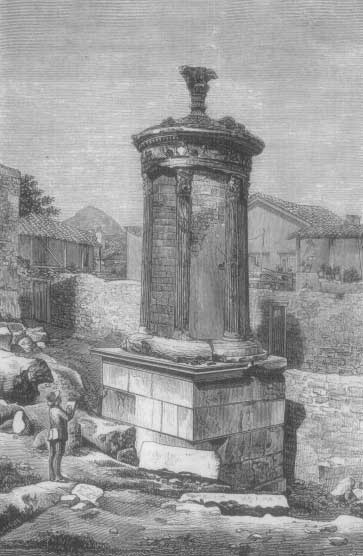
Old Drawing, 1873
| Ancient Greece
Science, Technology , Medicine , Warfare, , Biographies , Life , Cities/Places/Maps , Arts , Literature , Philosophy ,Olympics, Mythology , History , Images Medieval Greece / Byzantine Empire Science, Technology, Arts, , Warfare , Literature, Biographies, Icons, History Modern Greece Cities, Islands, Regions, Fauna/Flora ,Biographies , History , Warfare, Science/Technology, Literature, Music , Arts , Film/Actors , Sport , Fashion --- |

